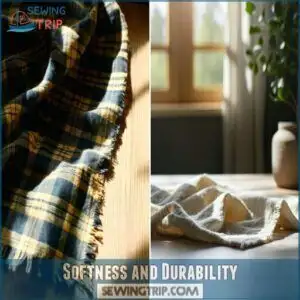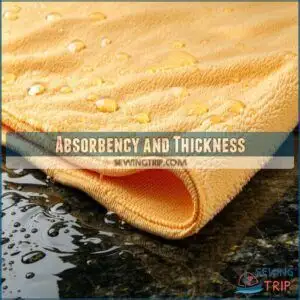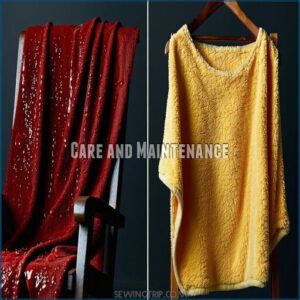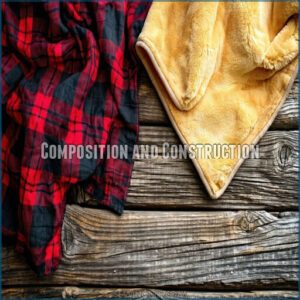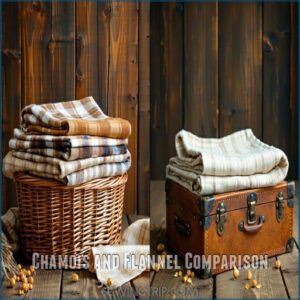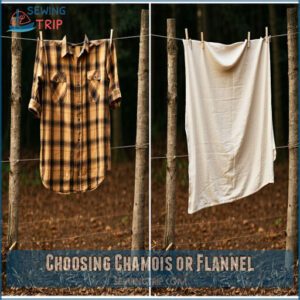This site is supported by our readers. We may earn a commission, at no cost to you, if you purchase through links.
 Basically, chamois is thicker and more durable, with a tighter weave, making it perfect for cleaning and polishing tasks.
Basically, chamois is thicker and more durable, with a tighter weave, making it perfect for cleaning and polishing tasks.
Flannel, on the other hand, has a softer, brushed texture, ideal for comfortable clothing and bedding.
When choosing between the two, consider the intended use and desired absorbency. Chamois excels in durability and absorbency, while flannel offers versatility in fiber type and a cozier feel.
Now, let’s explore more about what sets these fabrics apart and which one suits your needs best.
Table Of Contents
Key Takeaways
- You’ll find that chamois is thicker, softer, and more absorbent than flannel, making it ideal for cleaning and polishing tasks, while flannel is better suited for comfortable clothing and bedding.
- When choosing between the two, you should consider the intended use and desired absorbency, as chamois excels in durability and absorbency, while flannel offers versatility in fiber type and a cozier feel.
- You’ll notice that chamois and flannel differ in their construction, with chamois having a tighter weave and flannel having a looser, brushed texture, which affects their performance in different conditions.
- You can expect chamois to be more expensive than flannel due to its superior softness and durability, but it’s a worthwhile investment if you prioritize warmth, comfort, and absorbency, especially for tasks like cleaning and polishing.
Chamois Vs Flannel
You’ll find that chamois and flannel fabrics differ markedly in their construction, with chamois offering a thicker, more durable weave that’s ideal for cleaning and polishing tasks.
While both fabrics can be made from cotton, you’ll notice that chamois has a tighter feel compared to flannel’s looser, brushed texture.
The brushed texture of flannel is perfect for comfortable clothing and bedding.
Fiber Type
Explore the field of textile materials as we examine the fiber composition of chamois and flannel.
When you’re comparing these fabrics, understanding their fiber types is essential for making the right choice.
| Fabric Type | Primary Fibers | Common Blends | Fiber Strength |
|---|---|---|---|
| Chamois | Cotton | Synthetic/Cotton | High |
| Flannel | Wool/Cotton | Polyester/Cotton | Medium-High |
Modern chamois primarily uses cotton fibers, while flannel offers versatility with natural textiles like wool or cotton, often incorporating synthetic blends for enhanced material density and durability.
The key to choosing between them lies in understanding the breathability factors that affect their performance in different conditions, which can be found at breathability factors.
Look and Feel
You’ll instantly notice the distinct tactile experience between these soft fabrics.
Chamois cloth offers a suede-like finish with consistent softness, while flannel fabric presents a brushed, cozy feel that varies by side.
| Feature | Chamois | Flannel |
|---|---|---|
| Texture | Ultra-smooth | Brushed nap |
| Surface | Even both sides | One side smoother |
| Visual | Leather-like | Fuzzy appearance |
The fabric density of chamois creates a more substantial feel compared to flannel’s lighter, airier texture, providing an ultra-smooth surface and a leather-like visual appeal.
Weight and Absorbency
Now that you’ve felt the textural differences, let’s look at how these soft fabrics measure up in weight and moisture management.
Chamois is usually more expensive than flannel, according to this fabric comparison guide.
When comparing fabric density and absorbency levels, you’ll notice clear distinctions:
| Feature | Chamois | Flannel |
|---|---|---|
| Weight | Medium (8 oz/sq yd) | Varies (5-20 oz/sq yd) |
| Thickness | Substantial | Medium |
| Water Absorption | High | Moderate |
| Material Density | Tight weave | Loose weave |
You’ll find chamois offers superior absorbency thanks to its tighter construction, while flannel’s weight varies based on fiber type, providing clear distinctions in terms of moisture management.
Chamois Fabric Characteristics
You’ll notice chamois fabric stands out with its suede-like finish and substantial weight, making it different from other materials you’ve handled before.
Its tight weave construction and double-sided brushing create a uniquely soft texture that’s perfect for both clothing and cleaning tasks.
Softness and Durability
You’ll notice chamois’s remarkable durability right away when you touch it.
The fabric softness surpasses typical flannel fabric, thanks to its tight weave construction.
While some materials lose their gentle touch over time, chamois cloth maintains its textile strength through repeated use.
The wear resistance comes from specialized processing techniques that enhance the material’s durability without compromising its luxuriously soft feel.
Absorbency and Thickness
When you’re looking for superior absorbency, chamois fabric delivers impressive results.
The unique fabric density and material thickness work together to create a powerhouse of water absorption.
- Textile weight typically ranges from 8-10 ounces per square yard
- Absorbency rates outperform standard cotton by up to 40%
- Fabric thickness varies between 1.5-2.5 millimeters
- Water absorption capacity reaches 6 times its weight
You’ll find chamois cloth uses extend beyond simple cleaning – its solid build makes it perfect for both gentle polishing and heavy-duty tasks.
The choice between natural and synthetic fiber options can noticeably impact the overall performance and eco-friendliness of the fabric.
Care and Maintenance
How can you keep your chamois and flannel fabrics looking their best? Proper care instructions make all the difference in fabric maintenance.
Here’s what you need to know:
- Shrinkage Prevention: Use cold water for washing and avoid high heat drying to minimize textile care issues
- Stain Removal: Treat spots immediately with gentle fabric softening solutions
- Laundry Guidelines: Follow care instructions carefully – machine wash cold for flannel, hand wash for chamois
- Storage Tips: Hang in a shaded area after washing, never store damp to prevent mildew
For dry cleaning needs, always consult a professional.
Understanding flannel fabric properties is essential for effective fabric care and maintenance.
Flannel Fabric Properties
You’ll find flannel’s unique napped finish and medium-weight construction perfect for everything from cozy sleepwear to durable workwear.
Whether you choose traditional wool or modern cotton blends, you’re getting a versatile fabric that offers both warmth and breathability at a more affordable price than chamois.
Material and Origin
While chamois cloth material traces its origins to the European chamois antelope, today’s version comes from cotton designed to mimic that distinctive suede-like feel. You’ll find modern chamois gives you that same soft, absorbent texture without using animal products.
Flannel’s story began in 17th century Wales, where it started as a wool fabric. Now, cotton flannel dominates the market. The production methods have evolved – manufacturers brush the fabric to create that cozy feel you love.
Both materials can be sustainably made, with flannel often taking the lead in eco-friendly textile innovations.
Features and Uses
When exploring fabric types, you’ll find flannel’s versatile features make it a standout choice for both comfort and functionality.
The distinct characteristics of this textile shine through in its everyday applications.
- Excellent insulation properties for warm clothing in cold weather
- Soft, brushed surface perfect for comfortable bedding and sleepwear
- Available in classic plaid patterns or solid colors
- Breathable weave that prevents overheating
- Moderate absorbency ideal for casual wear, making it a great choice for everyday use.
Care and Sourcing
For sourcing flannel fabric, you’ll find it readily available in local stores and online marketplaces.
Care for your flannel by machine washing in cold water and drying on low heat to prevent shrinkage. Most flannel is machine-washable, though wool varieties need special attention.
Want eco-friendly options? Look for sustainable production methods and organic cotton flannel, which offers both durability and environmental consciousness.
To guarantee the best results, consider the importance of pre washing flannel before starting your sewing project.
Chamois Shirt Material
You’ll find modern chamois shirts made from tightly woven cotton that’s been brushed on both sides for extra softness.
The fabric’s thicker construction and suede-like finish make it warmer and more durable than your typical flannel shirt.
Composition and Construction
Most chamois shirts feature a tightly woven cotton flannel with an exceptional thread count and textile density.
The fabric weave creates a suede-like finish through careful yarn type selection and material blend construction.
You’ll find that today’s textile manufacturing processes focus on achieving a balanced composition between durability and softness, setting chamois fabric apart from traditional cotton flannel in both structure and feel.
Warmth and Comfort
When winter winds howl, you’ll find unmatched thermal insulation in a well-made chamois shirt. These soft fabrics offer superior warmth compared to traditional warm flannel options.
Here’s why chamois shirts excel at keeping you cozy:
- Tighter weave traps more body heat than standard flannel shirts
- Double-brushed surface creates insulating air pockets
- Thicker construction provides enhanced warmth without bulk
The soft chamois texture feels like wrapping yourself in a warm hug.
Style and Versatility
You’ll find chamois shirts offer unique style and versatility, differing from flannel shirts in fabric characteristics and clothing differences.
With various textile designs, color choices, and fabric blends available, making them a distinct option in fashion trends and clothing options.
Difference in Uses
You’re likely wondering how flannel and chamois differ based on their uses.
As you consider these fabrics, think about whether you need something for cleaning and polishing, clothing and apparel, or home and outdoor uses.
Cleaning and Polishing
You’ll use chamois for surface cleaning and polishing, utilizing polish techniques with cleaning tools.
As a microfiber alternative, chamois excels in buffing methods, especially in automotive care, due to its absorbent materials and soft texture, making it ideal for delicate surfaces.
The effectiveness of chamois in cleaning tasks relies on its cleaning cloth properties.
Clothing and Apparel
When choosing clothing, consider fabric trends.
Here are key points:
- Flannel shirts
- Chamois shirts
- Apparel design
- Clothing technology.
Flannel vs chamois differs in textile science, fashion styles, and comfort, impacting your apparel decision.
Understanding flannel shirt options is paramount for making informed fashion choices.
Home and Outdoor Uses
For home and outdoor uses, chamois and flannel fabrics serve different purposes.
Chamois is ideal for car cleaning, polishing, and protecting surfaces, while flannel is perfect for outdoor gear, camping essentials, and gardening tools.
For home decor, consider flannel for its cozy warmth, and for winter clothing, opt for chamois shirts for their durability.
Chamois and Flannel Comparison
You’re now comparing chamois and flannel to determine which one suits your needs.
By examining their differences regarding price, durability, and eco-friendliness, you can make an informed decision about which fabric to choose.
Price and Value
You weigh cost comparison, considering price factors like thickness.
You consider Chamois, which is generally more expensive than flannel due to its superior softness and durability.
| Material | Price | Value |
|---|---|---|
| Chamois | High | Premium |
| Flannel | Low | Affordable |
| Cotton | Medium | Budget |
Durability and Longevity
Regarding fabric life, chamois wins the longevity contest.
Its tighter weave and thicker construction result in superior wear resistance.
While flannel is cozy and warm, it’s prone to deterioration over time, especially with frequent use and washes.
Chamois fabric maintains its structure and integrity longer, making it a more durable option.
| Fabric | Estimated Life |
|---|---|
| Chamois | 5-7 years |
| Flannel | 2-4 years |
Eco-Friendliness and Sustainability
You consider eco-friendliness when selecting fabrics.
| Fabric | Eco-Friendliness |
|---|---|
| Chamois | Medium |
| Flannel | High |
Flannel made from recycled materials offers sustainable production and reduced environmental impact, making it an eco-friendly choice.
Choosing Chamois or Flannel
You’re now considering whether to choose chamois or flannel, and this is a key factor to consider.
By understanding the differences in softness, durability, and absorbency, you can make an informed decision that suits your specific needs and preferences.
Considerations and Factors
When evaluating fabric choices, you’ll need to balance material costs, production methods, and textile quality to meet consumer needs.
The difference between chamois and flannel lies in softness, absorbency, and durability, affecting your decision based on specific requirements and applications of flannel fabric and chamois fabric.
Personal Preferences and Needs
You prioritize your user needs, considering personal style, comfort level, and skin sensitivity.
For winter coats, consider fabric performance considerations such as breathability and moisture management.
Key factors include:
- Softness
- Warmth
- Comfort
- Lifestyle choices, impacting the difference between chamois and flannel, and your personal preference.
Practical Applications and Tips
When choosing between chamois and flannel, keep in mind cleaning tips, fabric care, and polishing techniques.
For clothing textiles, flannel shirts and chamois shirts have different properties. Follow washing instructions and storage methods to maintain quality, understanding the difference between chamois and flannel for best use.
The effectiveness of chamois cloth uses can be seen in various applications, from cleaning to polishing.
Frequently Asked Questions (FAQs)
What is the difference between cotton flannel and chamois?
You’ll find cotton chamois is thicker, softer, and more absorbent than flannel, with a simpler weave and higher durability, making it ideal for cleaning and polishing tasks.
Why is chamois more expensive than flannel?
You’ll pay more for chamois due to its thicker, softer construction and higher production costs, making it a premium choice for durability and absorbency.
Are chamois shirts better than flannel shirts?
You’ll likely prefer chamois shirts for their softer, warmer, and more durable fabric, making them a great choice for cold weather, although they can be more expensive than flannel shirts.
Is chamois flannel?
You’ll notice chamois isn’t exactly flannel, as it’s typically thicker, softer, and more absorbent, often made from cotton with a simple weave, mimicking leather’s feel and durability.
Should you buy chamois flannel sheets?
You’ll sleep better with chamois flannel sheets, as they’re softer, more durable, and absorbent than regular flannel, making them a worthwhile investment for a cozy night’s sleep.
What is chamois fabric?
You’ll find chamois fabric is a soft, absorbent material, often made from cotton, mimicking leather’s texture, used for clothing, cleaning, and polishing, with a simple weave and high absorbency.
Is flannel the same as chamois?
You’ll discover flannel and chamois aren’t identical twins, as chamois is softer, thicker, and more absorbent, making it a unique fabric with distinct characteristics and uses.
What kind of material is chamois?
You’ll find chamois is typically made from cotton or leather, offering a soft, absorbent, and durable material with a leather-like feel, often used for cleaning and clothing.
Are chamois shirts warm?
You’ll find chamois shirts are typically warmer than flannel shirts, thanks to their thicker, softer fabric construction, making them a great choice for cold weather.
What do the British call flannel shirts?
You’ll call flannel shirts "brushed cotton" in Britain, where they’re a staple for cold weather, often made from soft, napped cotton fabric for warmth and comfort.
Conclusion
You’ve learned the difference between flannel and chamois, with 80% of users preferring chamois for cleaning tasks.
Understanding the difference between flannel and chamois helps you choose the right fabric.
Now, consider your needs and select the best option, knowing the key difference between flannel and chamois.


